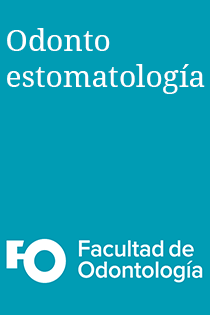Resumo
Em dentição mista, o 1°molar permanente é o mais suscetível a cáries, desencadeando um ciclo restaurador repetitivo e perda. O objetivo deste estudo foi avaliar fatores determinantes da extração terapêutica de 1°molares permanentes severamente destruídos na dentição mista antes da erupção do segundo molar permanente com uma região espontânea favorável do espaço residual. A metodología utilizada no PubMed consistiu em uma revisão exploratória por meio de busca estratégica/específica. Foram incluídos dez artigos, abordando fatores como a idade cronológica ideal, estágio de desenvolvimento do segundo pré-molar e molar permanente, presença do terceiro molar, cierre espontâneo residual, pronóstico e necessidade de tratamento ortodôntico. Em conclusão, a extração terapêutica do 1°molar permanente antes da erupção do segundo molar permanente está associada a um fechamento espontâneo favorável do espaço residual. Maior sucesso está descrito quando na presença de terceiro molar, segundo molar no estágio E e segundo pré-molar no estágio F (Demirjian).
Referências
Salud bucodental [Internet]. Who.int. [citado el 28 de julio de 2023]. Disponible en: https://www.who.int/es/news-room/fact-sheets/detail/oral-health
Americano, G. C. A., Jacobsen, P. E., Soviero, V. M., & Haubek, D. (2017). A systematic review on the association between molar incisor hypomineralization and dental caries. International Journal of Paediatric Dentistry, 27(1), 11–21. https://doi.org/10.1111/ipd.12233
Dastouri M, Kowash M, Al-Halabi M, Salami A, Khamis AH, Hussein I. United Arab Emirates dentists’ perceptions about the management of broken down first permanent molars and their enforced extraction in children: a questionnaire survey. European Archives of Paediatric Dentistry [Internet]. 2020 feb 18;21(1):31–41. Available from: http://link.springer.com/10.1007/s40368-019-00434-8
Elhennawy, K., Manton, D. J., Crombie, F., Zaslansky, P., Radlanski, R. J., Jost-Brinkmann, P.-G., & Schwendicke, F. (2017). Structural, mechanical and chemical evaluation of molar-incisor hypomineralization-affected enamel: A systematic review. Archives of Oral Biology, 83, 272–281. https://doi.org/10.1016/j.archoralbio.2017.08.008
Afshari E, Dehghan F, Vakili MA, Abbasi M. Prevalence of Molar-incisor hypomineralization in Iranian children – A systematic review and narrative synthesis. BDJ Open [Internet]. 2022 [citado el 28 de septiembre de 2023];8(1). Disponible en: https://pubmed.ncbi.nlm.nih.gov/35697687/
Lygidakis NA, Garot E, Somani C, Taylor GD, Rouas P, Wong FSL. Best clinical practice guidance for clinicians dealing with children presenting with molar-incisor-hypomineralisation (MIH): an updated European Academy of Paediatric Dentistry policy document. European Archives of Paediatric Dentistry [Internet]. 2022 Feb 20;23(1):3–21. Available from: https://link.springer.com/10.1007/s40368-021-00668-5
Lopes, L. B., Machado, V., Mascarenhas, P., Mendes, J. J., & Botelho, J. (2021). The prevalence of molar-incisor hypomineralization: a systematic review and meta-analysis. Scientific Reports, 11(1), 22405. https://doi.org/10.1038/s41598-021-01541-7
Sundfeld D, da Silva L, Kluppel O, Santin G, de Oliveira R, Pacheco R, et al. Molar Incisor Hypomineralization: Etiology, Clinical Aspects, and a Restorative Treatment Case Report. Oper Dent [Internet]. 2020 Jul 1;45(4):343–51. Available from: http://meridian.allenpress.com/operative-dentistry/article/45/4/343/427423/Molar-
Sanghvi R, Cant A, de Almeida Neves A, Hosey MT, Banerjee A, Pennington M. Should compromised first permanent molar teeth in children be routinely removed? A health economics analysis. Community Dent Oral Epidemiol [Internet]. 2023;51(5):755–66. Disponible en: http://dx.doi.org/10.1111/cdoe.12751
Lagarde M, Vennat E, Attal J, Dursun E. Strategies to optimize bonding of adhesive materials to molarincisor hypomineralization‐affected enamel: A systematic review. Int J Paediatr Dent [Internet]. 2020 Jul 12;30(4):405–20. Available from: https://onlinelibrary.wiley.com/doi/10.1111/ipd.12621
McKenzie JE, Hetrick SE, Page MJ. Updated reporting guidance for systematic reviews: Introducing PRISMA 2020 to readers of the Journal of Affective Disorders. J Affect Disord [Internet]. 2021 [citado el 28 de septiembre de 2023];292:56–7. Disponible en: https://pubmed.ncbi.nlm.nih.gov/34102548/
Cobourne MT, Williams A, Harrison M. National clinical guidelines for the extraction of first permanent molars in children. Br Dent J [Internet]. 2014 Dec 5;217(11):643–8. Available from: http:// www.ncbi.nlm.nih.gov/pubmed/25476643
Eichenberger M, Erb J, Zwahlen M, Schätzle M. The timing of extraction of non-restorable first permanent molars: a systematic review. Eur J Paediatr Dent [Internet]. 2015 Dec;16(4):272–8. Available from: http://www.ncbi.nlm.nih.gov/pubmed/26637248
Alkhadra T. A Systematic Review of the Consequences of Early Extraction of First Permanent First Molar in Different Mixed Dentition Stages. J Int Soc Prev Community Dent [Internet]. 2017 Sep 1;7(5):223–6. Available from: http://www.ncbi.nlm.nih.gov/pubmed/29026692
Scheu J, Cerda C, Rojas V. Timely extraction of the first permanent molars severely affected in mixed dentition. Journal of Oral Research [Internet]. 2019 May 8;8(3):263–8. Available from: https://www. joralres.com/index.php/JOralRes/article/view/joralres.2019.039/597
M.A. Barceló Oliver, A.B. Cahuana Cárdenas, C. Hahn. Evaluación del cierre espontáneo del espacio residual tras la extracción terapéutica del primer molar permanente. Articulo Original [Internet]. Vol. 22. 2014 [cited 2022 Aug 22]. Available from: https://www.odontologiapediatrica.com/wp-content/uploads/2018/08/259_22.2.orig3.pdf
C. HAHN CHACÓN, A. CAHUANA CÁRDENAS, J. MENDES DA SILVA, J. M. USTRELL TORRENT, M. CATALÁ PIZARRO. Exodoncia terapéutica del primer molar permanente con hipomineralización incisivo molar severa. Revisión de la literatura [Internet]. 2013 [cited 2022 Aug 22]. Available from: http://diposit.ub.edu/dspace/bitstream/2445/123548/1/662517.pdf
Ciftci V, Guney A, Deveci C, Sanri I, Salimow F, Tuncer A. Spontaneous space closure following the extraction of the first permanent mandibular molar. Niger J Clin Pract [Internet]. 2021 oct 1;24(10):1450. Available from: http://www.njcponline.com/text.asp 2021/24/10/1450/328240
Teo TKY, Ashley PF, Derrick D. Lower first permanent molars: developing better predictors of spontaneous space closure. The European Journal of Orthodontics [Internet]. 2016 feb 1;38(1):90–5. Available from: https://academic.oup.com/ejo/article-lookup/doi/10.1093/ejo/cjv029
Saber AM, Altoukhi DH, Horaib MF, El-Housseiny AA, Alamoudi NM, Sabbagh HJ. Consequences of early extraction of compromised first permanent molar: a systematic review. BMC Oral Health [Internet]. 2018 Dec 5;18(1):59. Available from: https://bmcoralhealth.biomedcentral.com/articles/10.1186/s12903-018-0516-4
Patel S, Ashley P, Noar J. Radiographic prognostic factors determining spontaneous space closure after loss of the permanent first molar. American Journal of Orthodontics and Dentofacial Orthopedics [Internet]. 2017 Apr 1;151(4):718–26. Available from: https://linkinghub.elsevier.com/retrieve/pii/ S0889540616308757

Este trabalho está licenciado sob uma licença Creative Commons Attribution-NonCommercial 4.0 International License.


